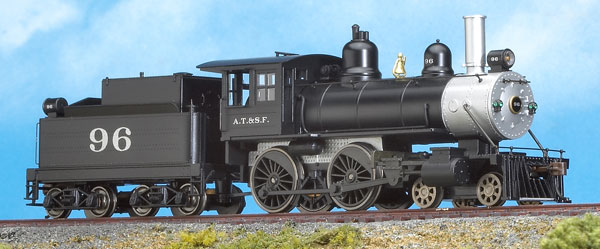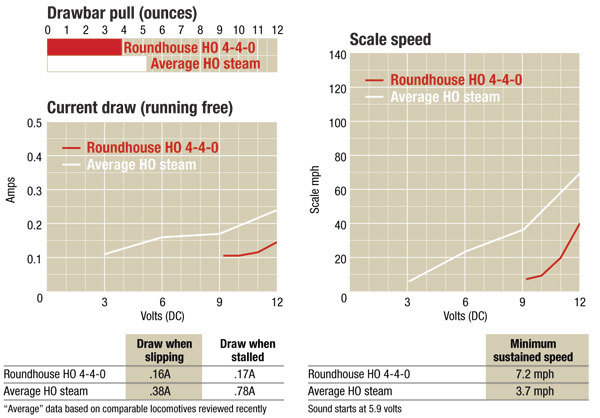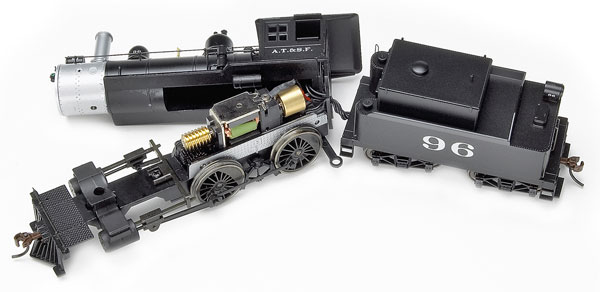The prototype. The 4-4-0 wheel arrangement dates to 1837, the year Henry Campbell invented the four-wheel swiveling front truck, a design particularly well suited for primitive track. In 1845, builders began making 4-4-0s in large numbers and kept making them for the next 50 years.
In the 1870s, an estimated 85 percent of all North American locomotives were 4-4-0s. The design was so popular that the wheel arrangement became known as “American Standard,” later shortened to “American.” The locomotives were light, sure-footed, mechanically simple, and easily adaptable.
Even when more-powerful locomotives appeared, “Eight-Wheelers,” as the type was also known, remained in use on branch lines where short passenger and freight trains were the norm and questionable track and light bridges precluded bigger locomotives.
Few Americans were built after 1900, but many of the 25,000 Eight-Wheelers remained in service on Class 1 railroads into the 1920s.
The die-cast metal boiler of the Roundhouse model adds useful heft – the engine alone weighs 8 ounces – however, the reworked Model Die Casting tooling is a little lacking in detail. For example, there is a sand dome but no associated sand piping.
The tender contains the dual-function Model Rectifier Corp. decoder and sound system. The locomotive’s National Model Railroad Association-compliant decoder supports all DCC programming methods, including register mode, paged mode, direct mode, and programming on the main.
In DC operation, the wireless sound controller allows users to blow the whistle, start and stop the bell, turn the headlight on and off, and raise and lower the volume. There’s also a button to activate a coupler-crash sound effect.
The model is smoothly painted in satin black with a silver smokebox and firebox (Santa Fe’s were tarpon gray; i.e., graphite). The valve gear, siderods, and truck wheels are blackened metal.
Performance. Although its starting speed was a tad high, our 4-4-0 did well on the test track. The front driver has traction tires on both wheels, and the rear driver and tender wheels pick up power. In common with most dual-mode sound-equipped models operating in DC, nothing much happens until quite a bit of power has been applied. The sound system starts at 5.9 volts, and the locomotive begins to move at 9.2 volts. Starting speed in DC was 7.2 mph, with a top speed of 40 mph at 12 volts. Speeds in DCC were better, ranging from 5.4 mph to 80 mph.
The dual traction tires and metal boiler combine to give the little Eight-Wheeler exceptional pulling power. On straight, level track, this 4-4-0 can handle a 50-car train.
Steam American style. With its early 20th century looks and 21st century control and sound, this 4-4-0 is an appealing combination of old and new.
Price: $225 with dual-mode DCC decoder and sound
Manufacturer:
Roundhouse Trains Division of Athearn Trains Inc.
1550 Glenn Curtiss St.
Carson, CA 90746
Phone: (310) 763-7140
www.roundhousetrains.com
Description
Ready-to-run plastic and metal 4-4-0 American
Road names
Two road numbers each with exception of painted but unlettered): Atchison, Topeka & Santa Fe; Baltimore & Ohio; Chicago & North Western; Denver & Rio Grande Western; Great Northern; New York Central; and undecorated
Automatic dual-mode (DC and DCC) digital sound and control system
Blackened RP-25 nickel-silver wheels, all correctly gauged
Engine weight: 8 ounces
(10½ ounces with tender)
Magnetic knuckle couplers
Minimum radius: 15″
Road-name-specific details
10-wheel electrical pickup
Wire handrails
Wireless remote control for DC sound operation
















